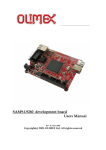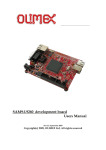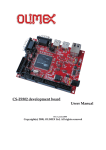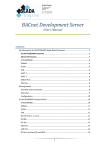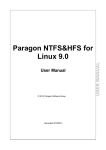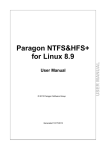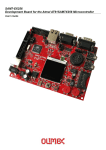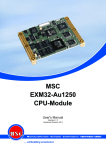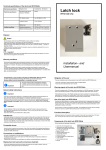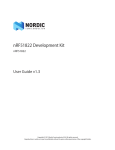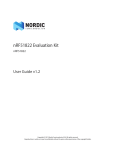Download SAM9-L9260 development board Users Manual
Transcript
SAM9-L9260 development board
Users Manual
All boards produced by Olimex are ROHS compliant
Rev.A, April 2008
Copyright(c) 2008, OLIMEX Ltd, All rights reserved
INTRODUCTION:
SAM9-L9260 is a low cost development platform with ARM9
microcontroller, 64MB SDRAM and 512MB NAND Flash. The board has
Ethernet 100Mbit controller, USB host, USB device, RS232 and a 40 pin
extension port with all unused SAM9260 ports available for add-on boards.
SAM9-L9260 has vast amounts of Flash and RAM and runs Linux,
WindowsCE and other RTOS natively. There is an on-board RTC clock with
3V Li battery backup.
BOARD FEATURES:
-
MCU: AT91SAM9260 16/32 bit ARM9™ 180MHz operation
standard JTAG connector with ARM 2x10 pin layout for
programming/debugging with ARM-JTAG
64 MB SDRAM
512MB NAND Flash (seen in Linux as silicon drive)
Ethernet 100Mbit connector
USB host and USB device connectors
RS232 interface and drivers
SD/MMC card connector
one user button and one reset button
one power and two status LEDs
on board voltage regulator 3.3V with up to 800mA current
single power supply: 5V DC required
power supply filtering capacitor
18.432 Mhz crystal
extension port
PCB: FR-4, 1.5 mm (0,062"), soldermask, silkscreen component
print
Dimensions: 100 x 80 mm (3.94 x 3.15")
ELECTROSTATIC WARNING:
The SAM9-L9260 board is shipped in protective anti-static packaging. The
board must not be subject to high electrostatic potentials. General practices
for working with static sensitive devices should be applied when working
with this board.
BOARD USE REQUIREMENTS:
Cables:
1.8 meter USB A-B cable to connect with USB host.
Null modem RS232 female – female to connect with PC COM
port.
Hardware:
ARM-JTAG, ARM-USB-OCD or other compatible tool if you
want to program this board with JTAG, usually with Linux
installed you can develop without the need for JTAG
Software:
The CD contains Linux 2.6 complete with source and binary
on CD
BOARD LAYOUT:
SCHEMATIC:
PROCESSOR FEATURES:
SAM9-L9260 board use CPU AT91SAM9260 from Atmel® with these
features:
- Incorporates the ARM926EJ-S™ ARM® Thumb® Processor
o DSP Instruction Extensions, ARM Jazelle® Technology for Java®
Acceleration
- External Bus Interface (EBI)
o Supports SDRAM, Static Memory, ECC-enabled NAND Flash and
CompactFlash®
- USB 2.0 Full Speed (12 Mbits per second) Device Port
o On-chip Transceiver, 2,432-byte Configurable Integrated DPRAM
- USB 2.0 Full Speed (12 Mbits per second) Host
- Ethernet MAC 10/100 Base T
o Media Independent Interface or Reduced Media Independent
Interface
o 28-byte FIFOs and Dedicated DMA Channels for Receive and
Transmit
- Bus Matrix
o Six 32-bit-layer Matrix
o Boot Mode Select Option, Remap Command
- Fully-featured System Controller, including
o Reset Controller, Shutdown Controller
o Four 32-bit Battery Backup Registers for a Total of 16 Bytes
o Clock Generator and Power Management Controller
o Advanced Interrupt Controller and Debug Unit
o Periodic Interval Timer, Watchdog Timer and Real-time Timer
- Reset Controller (RSTC)
o Based on a Power-on Reset Cell, Reset Source Identification and
Reset Output Control
- Clock Generator (CKGR)
o Selectable 32,768 Hz Low-power Oscillator or Internal Low
Power RC Oscillator on Battery Backup Power Supply, Providing
a Permanent Slow Clock
o 3 to 20 MHz On-chip Oscillator, One up to 240 MHz PLL and
One up to 130 MHz PLL
- Power Management Controller (PMC)
o Very Slow Clock Operating Mode, Software Programmable Power
Optimization Capabilities
o Two Programmable External Clock Signals
- Advanced Interrupt Controller (AIC)
o Individually Maskable, Eight-level Priority, Vectored Interrupt
Sources
o Three External Interrupt Sources and One Fast Interrupt
Source, Spurious Interrupt Protected
- Debug Unit (DBGU)
o 2-wire UART and Support for Debug Communication Channel,
Programmable ICE Access Prevention
- Periodic Interval Timer (PIT)
o 20-bit Interval Timer plus 12-bit Interval Counter
- Watchdog Timer (WDT)
o Key-protected, Programmable Only Once, Windowed 16-bit
Counter Running at Slow Clock
- Real-time Timer (RTT)
o 32-bit Free-running Backup Counter Running at Slow Clock
with 16-bit Prescaler
-
-
-
-
-
-
-
One 4-channel 10-bit Analog-to-Digital Converter
Three 32-bit Parallel Input/Output Controllers (PIOA, PIOB, PIOC)
o 96 Programmable I/O Lines Multiplexed with up to Two
Peripheral I/Os
o Input Change Interrupt Capability on Each I/O Line
o Individually Programmable Open-drain, Pull-up Resistor and
Synchronous Output
o – High-current Drive I/O Lines, Up to 16 mA Each
Peripheral DMA Controller Channels (PDC)
One Two-slot MultiMedia Card Interface (MCI)
o SDCard/SDIO and MultiMediaCard™ Compliant
o Automatic Protocol Control and Fast Automatic Data Transfers
with PDC
One Synchronous Serial Controller (SSC)
o Independent Clock and Frame Sync Signals for Each Receiver
and Transmitter
o I²S Analog Interface Support, Time Division Multiplex Support
o High-speed Continuous Data Stream Capabilities with 32-bit
Data Transfer
Four Universal Synchronous/Asynchronous Receiver Transmitters
(USART)
o Individual Baud Rate Generator, IrDA® Infrared
Modulation/Demodulation, Manchester Encoding/Decoding
o Support for ISO7816 T0/T1 Smart Card, Hardware
Handshaking, RS485 Support
o Full Modem Signal Control on USART0
Two 2-wire UARTs
Two Master/Slave Serial Peripheral Interfaces (SPI)
o 8- to 16-bit Programmable Data Length, Four External
Peripheral Chip Selects
o Synchronous Communications
Two Three-channel 16-bit Timer/Counters (TC)
o Three External Clock Inputs, Two Multi-purpose I/O Pins per
Channel
o Double PWM Generation, Capture/Waveform Mode, Up/Down
Capability
o High-Drive Capability on Outputs TIOA0, TIOA1, TIOA2
One Two-wire Interface (TWI)
o Master, Multi-master and Slave Mode Operation
o General Call Supported in Slave Mode
IEEE® 1149.1 JTAG Boundary Scan on All Digital Pins
Required Power Supplies:
o 1.65V to 1.95V for VDDBU, VDDCORE and VDDPLL
o 1.65V to 3.6V for VDDIOP1 (Peripheral I/Os)
o 3.0V to 3.6V for VDDIOP0 and VDDANA (Analog-to-digital
Converter)
o Programmable 1.65V to 1.95V or 3.0V to 3.6V for VDDIOM
(Memory I/Os)
AT91SAM9260 Block Diagram
MEMORY MAP:
POWER SUPPLY CIRCUIT:
The power supply for SAM9-L9260 must be regulated +5VDC, please apply
exactly 5V as the same power line goes to USB hosts and if you apply over 5V
you will damage the USB devices attached to the host.
The current consumption is typical 250mA with 180 MHz clock of SAM9260
and 90MHz clock of external bus.
For the RTC there is a battery backup power supply from a small 3V Li
battery type CR2032.
RESET CIRCUIT:
SAM9-L9260 reset circuit contains a 4.7k pull-up resistor and RST button
connected to GND.
CLOCK CIRCUIT:
Quartz crystal Q1-18.432Mhz is connected to SAM9-L9260 Xin and Xout
pins.
Quartz crystal Q2-32768Hz is connected to SAM9-L9260 Xin32 and Xout32
pins.
JUMPER DESCRIPTION:
SMD jumper description
3.3V_E
This jumper connects the output of main 3.3V regulator
VR1(3.3V)-RC1587 to the rest part of schematic. It is useful to
measure the current consumption.
Default state - closed
3.3V_MCU_E This jumper connects 3.3V to the SAM9260 microcontroller.
It is useful to measure the current consumption.
Default state - closed
1.8V_MCU_E This jumper connects 1.8V to the SAM9260 microcontroller.
It is useful to measure the current consumption.
Default state - closed
BDS_E
BounDary Scan Enable. The BDS_E jumper is used to select
the JTAG boundary scan when JTAGSEL pin asserted at a
high level (tied to VDDBU). This pin integrates a permanent
pull-down resistor of about 15KΩ to GNDBU. When BDS_E is
open JTAG function is selected.
Default state – open
TCK-RTCK Connects RTCK and TCK pins of SAM9260.
Default state open
WPE
Connects PC4(pin62) to Write Protection pin of SD/MMC
socket. If WP function is not used, WPE jumper has to be open
and PC4 is available of EXT connector pin 20.
Default state - closed
CPE
Connects PC8(pin61) to Card Present pin of SD/MMC socket.
If CP function is not used, CPE jumper has to be open and
PC8 is available of EXT connector pin 14.
Default state - closed
NTRST_E
When the NTRST_E jumper is closed – connects NTRST(pin 35)
to JTAG connector (pin3).
Default state - closed
WP_SFLASH_E
When the WriteProtect_SerialFLASH_Enable jumper is
closed it allows to protect the boot code written to
U5(AT45DB161D-SU) flash memory.
Default state open
WP_NFLASH_E
When the WriteProtect_NandFLASH_Enable jumper is
closed user can't write in the NAND flash.
Default state open
A2_L/A2_H Connects Address2(A2)pin of U8-24LC256 memory (default not
mounted) to logical 0 or logical 1, i.e. A2_L/A2_H define the
memory address of I2C bus.
Default state - open
PTH jumper description:
BMS_LOW
Boot Mode Sellect _ LOW jumper select the boot memory
External memory or embedded ROM. When BMS_LOW is
closed – BMS pin is logical 0, otherwise – logical 1.
Default state - open
BAT/EXT
BMS_LOW
The BATerry/EXTernal jumper defines the power source which
supplied backup logic from VDDBU – pin 47.
BAT position – 3V Li battery type CR2032 plugged in BAT
holder supplied VDDBU through backup VR3(1.8V)
MCP1700T-1802E/MB voltage regulator.
EXT position – The VDDBU is powered from main 1.8V voltage
regulator VR2(1.8V) – LM1117.
Default state
BAT/EXT
INTRC/EXTCLK
The INTRC/EXTCLK jumper defines SAM9260 slow clock
source.
INTRC position – internal RC slow clock oscilator is selected
EXTCLK position – external 32768 crystal is used for
SAM9260 slow clock.
Default state
INTRC/EXTCLK
RXD1/DRXD
The RXD1/DRXD jumper defines which pin - RXD1 or DRXD
is connected to RS232 driver (ST3232), i.e. the board allows
comunication with PC COM port through RXD1 or DRXD.
RXD1 position – RXD1 function of SAM9260 pin 18 is tied to
pin12(R1OUT) of U6(ST3232).
DRXD position – DRXD function of SAM9260 pin 21 is tied to
pin12(R1OUT) of U6(ST3232).
Default state
RXD1/DRXD
TXD1/DTXD
The TXD1/DTXD jumper defines which pin TXD1 or DTXD is
connected to RS232 driver (ST3232), i.e. the board allows
comunication with PC COM port through TXD1 or DTXD.
TXD1 position – TXD1 function of SAM9260 pin 17 is tied to
pin11(T1IN) of U6(ST3232).
DTXD position – DTXD function of SAM9260 pin 22 is tied to
pin11(T1IN) of U6(ST3232).
Default state
TXD1/DTXD
PHY_PDE/PHY_PDCTRL
PHY_PDE position – The PHY chip U7(KS8721BL) enter to
power down mode.
PHY_PDCTRL position – The PHY chip power down mode is
controled from SAM9260 PC1(pin58).
OPEN position – The PHY chip is alwаys enabled.
Default state- open
NANDF_E
The NANDFlash_Enable allows PC14/NAND_CS pin of
SAM9260 to controls CE pin of NAND FLASH memory
U3(K9F4G08UXM). If the board has to boot from NAND flash
the NANDF_E jumper must be closed.
Default state- close
DF_E
PHY_PDE/PHY_PDCTRL
NANDF_E
The DataFlash_Enable allows PC11/SPI0_NPCS1 pin of
SAM9260 to controls CS pin of serial Data Flash memory
U5(AT45DB161D-SU). If the board has to boot from Data Flash
the DF_E jumper must be closed.
Default state- open
DF_E
INPUT/OUTPUT:
RS232_0 is used as the Linux console, so you can connect with a terminal
program and work at command prompt.
The cable between SAM9-L9260 and PC must be female – female, null
modem type. Terminal settings are 115200 , 8bits, 1stop, no parity, no flow
control.
User button named BUT – connected to SAM9260 pin127 PC15(IRQ1);
Status green LED with name STAT (SAM9260 pin185 PA6) is connected to
the system timer and blinks every second.
Power supply yellow LED with name PWR_LED indicates the state of
SAM9260. It is linked to the CPU load and is on when the CPU is idle.
The LED PWR_5V (red) indicates +5V presence to the board.
EXTERNAL CONNECTOR DESCRIPTION:
JTAG:
The JTAG connector allows software debugger to talk via a JTAG (Joint Test
Action Group) port directly to the core. Instructions may be inserted and
executed by the core thus allowing SAM9260 memory to be programmed
with code and executed step by step by the host software.
For more details refer to IEEE Standard 1149.1 - 1990 Standard Test
Access Port and Boundary Scan Architecture and SAM9260 datasheets and
users manual.
Pin #
Signal Name
Pin #
Signal Name
1
VCC
2
VCC
3
ICE_NTRST
4
GND
5
TDI
6
GND
7
TMS
8
GND
9
TCK
10
GND
11
RTCK
12
GND
13
TDO
14
GND
15
ICE_NRST
16
GND
17
NC
18
GND
19
NC
20
GND
Standard 20 pin ARM JTAG connector for programming and debugging.
UEXT
Pin #
Signal Name
1
VCC
2
GND
3
PB8(TXD2)
4
PB9(RXD2)
5
PA24_TWCK
6
PA23_TWD
7
PB0(SPI1_MISO)
8
PB1(SPI1_MOSI)
9
PB2(SPI1_SPCK)
10
PB3(SPI1_NPCS0)
UEXT is a universal OLIMEX connector with 3.3V power supply and UART,
I2C and SPI interface. Other device or modules with these interfaces can
connected with UEXT. For example: MOD-NRF24L, MOD-RFID125, MODMP3 and many other are on the way
SPI:The
Serial Peripheral Interface (SPI) circuit is a synchronous serial
data link that provides communication with external devices in Master or
Slave Mode. It also enables communication between processors if an
external processor is connected to the system.
I2C:
The Atmel Two-wire Interface (TWI) interconnects components on a
unique two-wire bus, made up of one clock line and one data line with
speeds of up to 400 Kbits per second, based on a byte-oriented transfer
format. It can be used with any Atmel two-wire bus Serial
EEPROM. The TWI is programmable as a master or a slave with sequential
or single-byte access. Multiple master capability is supported. Arbitration of
the bus is performed internally and puts the TWI in slave mode
automatically if the bus arbitration is lost. A configurable baud rate
generator permits the output data rate to be adapted to a wide range of core
clock frequencies.
UART:
The Universal Synchronous Asynchronous Receiver Transmitter
(USART) provides one full duplex universal synchronous asynchronous
serial link. Data frame format is widely programmable (data length, parity,
number of stop bits) to support a maximum of standards. The receiver
implements parity error, framing error and overrun error detection. The
receiver timeout enables handling variable-length frames and the
transmitter timeguard facilitates communications with slow remote devices.
Multidrop communications are also supported through address bit
handling in reception and transmission.
RS232 connector:
Pin #
USB_D
Signal Name
1
NC
2
RXD
3
TXD
4
6
5
GND
6
4
7
RTS
8
CTS
9
NC
The USB Device Port (UDP) is compliant with the Universal Serial Bus
(USB) V2.0 full-speed device specification. Each endpoint can be
configured in one of several USB transfer types. It can be associated with
one or two banks of a dual-port RAM used to store the current data
payload. If two banks are used, one DPR bank is read or written by the
processor, while the other is read or written by the USB device peripheral.
This feature is mandatory for isochronous endpoints. Thus the device
maintains the maximum bandwidth (1M bytes/s) by working with
endpoints with two banks of DPR.
Pin #
Signal Name
1
+5V(input)
2
USBDM
3
USBDP
4
GND
USB_A:
Pin #
Signal Name
1
+5V(Out)
2
HDMA
3
HDPA
4
GND
USB host with +5V power line direct connected through 300mA resetable
fuse to power jack.
The USB Host Port (UHP) interfaces the USB with the host application. It
handles Open HCI protocol (Open Host Controller Interface) as well as USB
v2.0 Full-speed and Low-speed protocols. The USB Host Port integrates a
root hub and transceivers on downstream ports. It provides several highspeed half-duplex serial communication ports at a baud rate of 12 Mbit/s.
Up to 127 USB devices (printer, camera, mouse, keyboard, disk, etc.) and
the USB hub can be connected to the USB host in the USB “tiered star”
topology. The USB Host Port controller is fully compliant with the Open HCI
specification. The standard OHCI USB stack driver can be easily ported to
Atmel’s architecture in the same way all existing class drivers run without
hardware specialization.
LAN:
The EMAC module implements a 10/100 Ethernet MAC compatible with
the IEEE 802.3 standard using an address checker, statistics and control
registers, receive and transmit blocks, and a DMA interface. The address
checker recognizes four specific 48-bit addresses and contains a 64-bit
hash register for matching multicast and unicast addresses. It can
recognize the broadcast address of all ones, copy all frames, and act on an
external address match signal.
Pin #
Signal Name
1
TD+
2
TD-
3
RD+
4
GND_LAN
5
GND_LAN
6
RD-
7
GND_LAN
8
GND_LAN
LED
Color
Usage
Right
Yellow
Activity
Left
Green
100MBits/s (Half/Full duplex)
EXT:
Pin #
Signal Name
Pin #
Signal Name
1
3.3V(OUT)
2
3.3V(OUT)
3
PC15/NWAIT/IRQ1
4
+5V(OUT)
5
PB0/SPI1_MISO/TIOA3
6
PC14/NCS3/NANDCS/IRQ2
NAND Flash Chip select MCU out
7
PB1/SPI1_MOSI/TIOB3
8
PC13/FIQ/NCS6
NAND Flash RDY/BSY MCU in
9
PB2/SPI1_SPCK/TIOA4
10
PC10/A25/CFRNW/CTS3
11
PB3/SPI1_NPCS0/TIOA5
12
PC9/NCS5/CFCS1/TIOB0
13
PB4/TXD0
14
PC8/NCS4/CFCS0/RTS3
15
PB5/RXD0
16
PC7/TIOB1/CFCE2
17
PB8/TXD2
18
PC6/TIOB2/CFCE1
19
PB9/RXD2
20
PC4/A23/SPI1_NPCS2
21
PB10/TXD3/ISI_D8
22
PB31/PCK1/ISI_MCK
23
PB11/RXD3/ISI_D9
24
PB30/PCK0/ISI_HSYNC
25
PB16/TK0/TCLK3
26
PB29/CTS1/ISI_VSYNC
RS232_0 CTS – MCU input
27
PB17/TF0/TCLK4
28
PB28/RTS1/ISI_PCK
RS232_0 RTS – MCU output
29
PB18/TD0/TIOB4
30
PB27/CTS0/ISI_D7
31
PB19/RD0/TIOB5
32
PB26/RTS0/ISI_D6
33
PB20/RK0/ISI_D0
34
PB25/RI0/ISI_D5
35
PB21/RF0/ISI_D1
36
PB24/DTR0/ISI_D4
37
PB22/DSR0/ISI_D2
38
PB23/DCD0/ISI_D3
39
GND
40
GND
This is provision for 40 pin external connector (not mounted) with all
unused SAM9260 ports available for user applications and add-on boards.
MECHANICAL DIMENSIONS:
SOFTWARE development with SAM9-L9260:
Overview
The board comes with Linux preloaded in the NAND flash. It's based on a
custom-built kernel and a Debian 4.0 userland. To use it, connect a nullmodem cable to the board and to a serial port on your computer, start a
terminal program (e.g. HyperTerminal on Windows, minicom on Unix
systems) and configure it to use a 115200 baud rate, 8 data bist, 1 stop bit
and no parity and no flow control. Then apply power to the board (use a
5VDC regulated power supply with at least 500mA output current) and
you should see the board start-up messages.
The default root password is 'olimex'
Restoring the default bootloader and kernel
If for some reason you need to restore the default factory
configuration of the board, the procedure is as follows:
First install the ATMEL AT91-ISP package which comes on the
disk. Reboot the computer if needed and copy the
NANDFLASH.tcl file from the ATMEL directory on the CD to
"C:\Program Files\ATMEL Corporation\AT91-ISP v1.9\SAM-BA
v2.5\lib\AT91SAM9260-EK".
Remove the NANDF_E and DF_E jumpers on the SAM9-L9260
board and power it up. Connect an USB cable to the USB_D
connector on the board and wait for the board to be detected
(if necessary install the USB driver, available in the
“atmel/samba driver/” directory).
Close the NANDF_E jumper and run the
AT91SAM9260_demo_linux_NandFlash.bat file from the sam9l9260-samba directory. After a while the log file will be
displayed and the system should be restored to the default
state.
WARNING! This procedure erases the whole NAND flash and
the root filesystem will also be destroyed in the process.
Restoring the on-board root filesystem
Boot-up the board with an alternate root filesystem (e.g. a USB flash drive,
NFS exported filesystem...) and use the following command (assuming that
the rootjffs2.img file is available in.)
sam9-l9260:~# flash_eraseall -j /dev/mtd1
sam9-l9260:~# nandwrite -a /dev/mtd1 /rootjffs2.img
You may get some errors about bad blocks not being erased - this is
normal and is related to the priciple of operation of NAND flashes. After the
process is completed, reboot the board.
Running with another root filesystem
You may choose to use another media for the root filesystem
for various reasons - more capacity, faster access, etc. A
complete root tree is archived in the root_sam9_fs.tgz file
which can be extracted to an empty ext3 partition on an USB
drive or to some exported via NFS directory. Then you need to
tell the kernel where to find the root - this is accomplished by
interrupting the u-boot process at the "Hit any key to stop
autoboot:..." prompt and setting the bootargs variable. For
example, to boot from a USB flash drive, the command is:
U-Boot> setenv bootargs mem=64M console=ttyS0,115200
root=/dev/sda1 rootdelay=10
and for booting from an NFS server at adress 192.168.0.75:
U-Boot> setenv bootargs mem=64M console=ttyS0,115200
root=/dev/nfs nfsroot=192.168.0.75:nfsroot
ip=192.168.0.222:192.168.0.75
Building a custom kernel
The recommended build method is to use a cross-compiler. Building
natively should also work but will be very time-consuming. At the moment
of writing, the current kernel version was 2.6.23, of which a tarball is
provided. You also need to apply the two patches in the linux directory the 2.6.23-rc3-at91.patch needs to be applied first. It adds general support
for at91-based boards to the kernel. The sam9_l9260.diff adds support for
the Olimex SAM9-L9260 board and should be applied second. After that,
you can build the default kernel by typing
$ make ARCH=arm CROSS_COMPILE=arm-linux- sam9_l9260_defconfig
$ make ARCH=arm CROSS_COMPILE=arm-linux- uImage
After the compilation, the kernel should be available at
arch/arm/boot/uImage
If the build process fails to detect the mkimage program, it is available in
the u-boot archive
The new kernel can be transferred to the board by various means - e.g. use
the board restoration process and change the kernel in there, tftpboot-ing
the board, etc.
Building the bootstrap binary
Extract the sources from boot/at91bootstrap-2.3-olimex_18.04.08.tgz to
your working directory and issue the following commands (substituting
<your-compiler-prefix-> with e.g. arm-linux- )
$ make CROSS_COMPILE=<your-compiler-prefix-> MEMORY=nandflash
at91sam9260ek_defconfig
$ make CROSS_COMPILE=<your-compiler-prefix-> MEMORY=nandflash
If everything is correct, the resulting binary file will be located in the
/binaries directory.
Building U-Boot
Extract the sources from boot/u-boot-1.2.0-atmel-olimex_18_04_08.tgz,
and issue:
$ make CROSS_COMPILE=<your-compiler-prefix-> sam9l9260_config
$ make CROSS_COMPILE=<your-compiler-prefix->
WARNING! Some compiler revisions seem to produce incorrect code and
although the compilation succeedes, the resultant u-boot binary is not
working - it will either hang completely without any output or will restart
when detecting the NAND flash. The only revision that is known to work
reliably is gcc-3.4.3, while gcc-4.0.1 and 4.1.1 are known to be broken.
Cross-compiling a simple "hello world" example
Extract one of the provided cross-compilers on your host system and add it
to the PATH variable. Use the cross-compiler to build the example, then
transfer it to the board by e.g. USB flash drive, http download etc.
Example commands:
----- On the host system -----
$ PATH=$PATH:/usr/local/arm/4.1.1-920t/bin
$ cat > hello.c
#include <stdio.h>
int main(void)
{
unsigned int i;
printf("\r\nProba proba ");
for (i=0; i<10; i++)
printf("\r\n%d", i);
return 0;
}
^D
$ arm-linux-gcc -o hello hello.c
$ cp hello ~/htdocs/
----- On the board ----~ # wget http://192.168.0.xx/hello
~ # chmod 777 hello
~ # ./hello
Proba proba
0
1
....
Using JTAG to program the board
A sample project is provided in the “TEST_BUTT” directory that
demonstrates how to write a project that runs directly on the core, without
the need of an operating system. It was developed using IAR Embedded
Workbench for ARM ver. 4.42A with a Segger J-Link JTAG adapter
Common Questions
Q: When booting from the internal NAND flash the board seems to hang at
"INIT: version 2.86 booting" and/or "Activating swap...done" lines
A: When mounting the JFFS2 root filesystem, the system performs a
consistency check (similar to fsck). This almost blocks all access to the
nand flash and the system appears to hang. Please wait - on a first boot of
a new filesystem this could take up to 5 minutes and is normal.
Q: There are messages "Buffer I/O error on device mtdblock0, logical block
0;end_request: I/O error, dev mtdblock0, sector 0" during boot-up. Is there
a problem on the board?
A: These messages indicate incorrect OOB records in the part of the flash
where the bootloader is stored and are due to the version of SAM-BA which
is used to write the various parts of the bootloader. We consider the above
messages as harmless.
Q: Why use an older version of SAM-BA with the OOB problem described
above?
A: Because the used u-boot bootloader is unable to understand the
(correct) new OOB layout. This should be corrected in the new revisions.
Q: The I/O operations are slow when using the on-board nand flash or
USB flash drive.
A: When doing a sequential read/write (e.g. one single large file) flash
memories can be fast. When reading/writing many small files the
performance will be really low.
Q: How to boot from the on board DataFlash?
A: Make sure that NANDF_E jumper is not connected and DF_E jumer is
connected. If the dataflash has been correctly programmed, the board
should start up.
Q: Is the SD/MMC card supported?
A: The SD/MMC card is fully supported, including detection of card
insertion/removal and write lock
Q: What do the two LED's indicate?
A: These two leds are driven by default by the linux LED driver. The green
one is connected to the system timer and blinks every second. The second
one(orange) is linked to the CPU load and is on when the CPU is idle.
Q: The system time is lost after reset, how to avoid that?
A: Unfortunately the Linux AT91SAM9 RTC driver is not yet operational.
When it is completed, you would just need a standard 3V battery at the
socket at the back of the board. Until then please set the date manually or
use a network time synchronization utility as ntpdate.
Q: What is the default IP address of the board?
A: The board is configured to use DHCP to automatically detect it's
address. If a DHCP server is not available, it will fallback to using
192.168.0.220
Acknowledgemens:
The kernel used is based on Linux-2.6.23 with patches available from
http://maxim.org.za
The root filesystem is based on the NSLU2 debian filesystem, available
from http://www.cyrius.com/debian/nslu2/
The bootloader is based on the u-boot-1.2.0 and at91bootstrap-2.3
packages, provided by ATMEL at http://www.at91.com
The cross-compilers are available from various sources on the Internet,
namely http://arm.cirrus.com/
All of the above packages are distributed under the GPL and/or another
free license (e.g. BSD license).
ORDER CODE:
SAM9-L9260 – assembled and tested (no kit, no soldering required)
How to order?
You can order to us directly or by any of our distributors.
Check our web www.olimex.com/dev for more info.
All boards produced by Olimex are RoHS compliant
Revision history:
REV.A
- create April 2008
Disclaimer:
© 2008 Olimex Ltd. All rights reserved. Olimex®, logo and combinations thereof, are registered trademarks of
Olimex Ltd. Other terms and product names may be trademarks of others.
The information in this document is provided in connection with Olimex products. No license, express or implied
or otherwise, to any intellectual property right is granted by this document or in connection with the sale of Olimex
products.
Neither the whole nor any part of the information contained in or the product described in this document may be
adapted or reproduced in any material from except with the prior written permission of the copyright holder.
The product described in this document is subject to continuous development and improvements. All particulars of
the product and its use contained in this document are given by OLIMEX in good faith. However all warranties
implied or expressed including but not limited to implied warranties of merchantability or fitness for purpose are
excluded.
This document is intended only to assist the reader in the use of the product. OLIMEX Ltd. shall not be liable for
any loss or damage arising from the use of any information in this document or any error or omission in such
information or any incorrect use of the product.


























